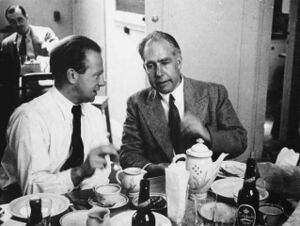Uncertainty principle (nonfiction): Difference between revisions
No edit summary |
|||
| Line 1: | Line 1: | ||
[[File:Heisenberg and Bohr.jpg|thumb|[[Werner Heisenberg (nonfiction)|Werner Heisenberg]] and [[Niels Bohr (nonfiction)|Niels Bohr]].]]In quantum mechanics, the '''uncertainty principle''', also known as '''Heisenberg's uncertainty principle''', is any of a variety of mathematical inequalities asserting a fundamental limit to the precision with which certain pairs of physical properties of a particle, known as complementary variables, such as position x and momentum p, can be known. | [[File:Heisenberg and Bohr.jpg|thumb|[[Werner Heisenberg (nonfiction)|Werner Heisenberg]] and [[Niels Bohr (nonfiction)|Niels Bohr, who may or may not be discussing the uncertainty principle in this 1934 photograph.]].]]In quantum mechanics, the '''uncertainty principle''', also known as '''Heisenberg's uncertainty principle''', is any of a variety of mathematical inequalities asserting a fundamental limit to the precision with which certain pairs of physical properties of a particle, known as complementary variables, such as position x and momentum p, can be known. | ||
Introduced first in 1927, by the German physicist [[Werner Heisenberg (nonfiction)|Werner Heisenberg]], it states that the more precisely the position of some particle is determined, the less precisely its momentum can be known, and vice versa. | Introduced first in 1927, by the German physicist [[Werner Heisenberg (nonfiction)|Werner Heisenberg]], it states that the more precisely the position of some particle is determined, the less precisely its momentum can be known, and vice versa. | ||
Revision as of 19:49, 25 January 2017
In quantum mechanics, the uncertainty principle, also known as Heisenberg's uncertainty principle, is any of a variety of mathematical inequalities asserting a fundamental limit to the precision with which certain pairs of physical properties of a particle, known as complementary variables, such as position x and momentum p, can be known.
Introduced first in 1927, by the German physicist Werner Heisenberg, it states that the more precisely the position of some particle is determined, the less precisely its momentum can be known, and vice versa.
The formal inequality relating the standard deviation of position σx and the standard deviation of momentum σp was derived by Earle Hesse Kennard later that year and by Hermann Weylin 1928.
Historically, the uncertainty principle has been confused with a somewhat similar effect in physics, called the observer effect, which notes that measurements of certain systems cannot be made without affecting the systems, that is, without changing something in a system. Heisenberg offered such an observer effect at the quantum level (see below) as a physical "explanation" of quantum uncertainty.
It has since become clear, however, that the uncertainty principle is inherent in the properties of all wave-like systems, and that it arises in quantum mechanics simply due to the matter wave nature of all quantum objects. Thus, the uncertainty principle actually states a fundamental property of quantum systems, and is not a statement about the observational success of current technology. Measurement does not mean only a process in which a physicist-observer takes part, but rather any interaction between classical and quantum objects regardless of any observer.
In the News
Werner Heisenberg quite certain about the uncertainty principles.
Fiction cross-reference
Nonfiction cross-reference
External links:
- Uncertainty principle @ Wikipedia

